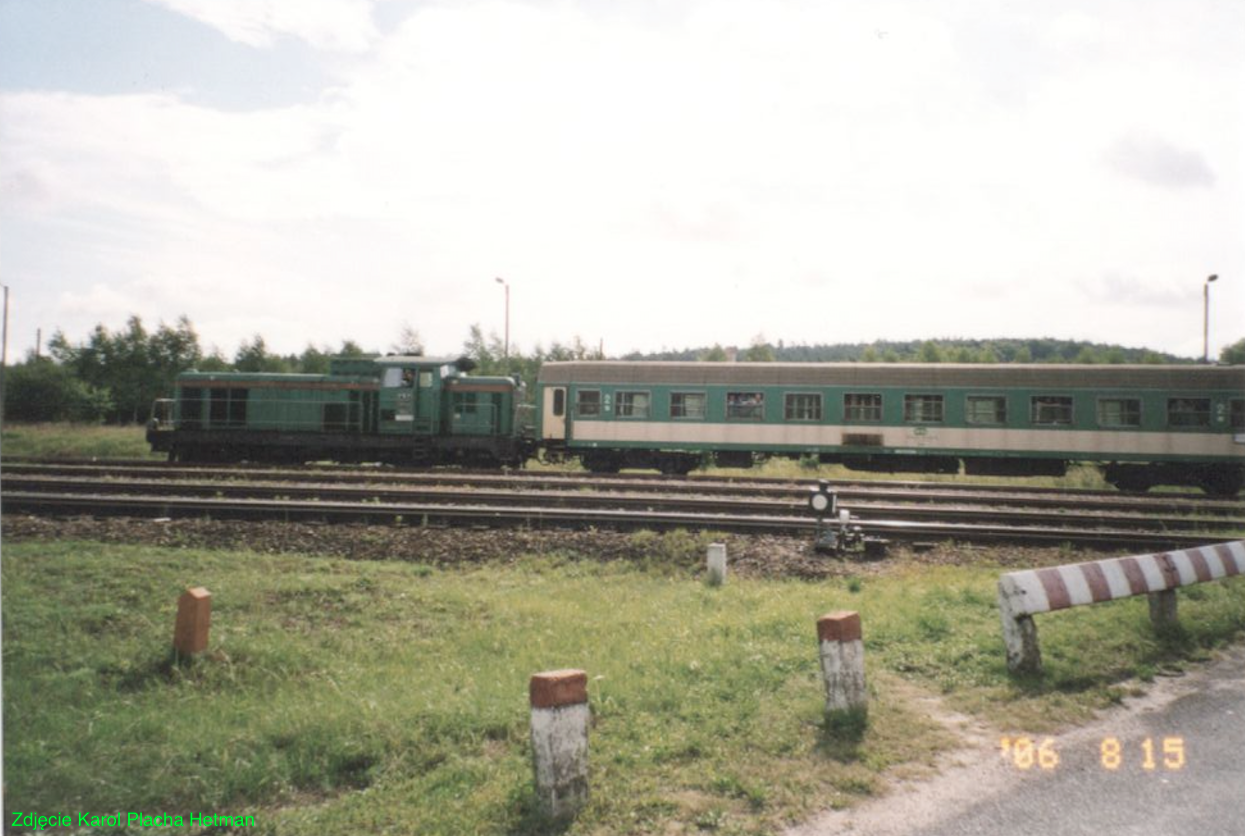Zamość 2022-04-19
Railway in the Zamojszczyzna region.
Geographic coordinates: 50.713N 23.238E. Elevation 206 m.
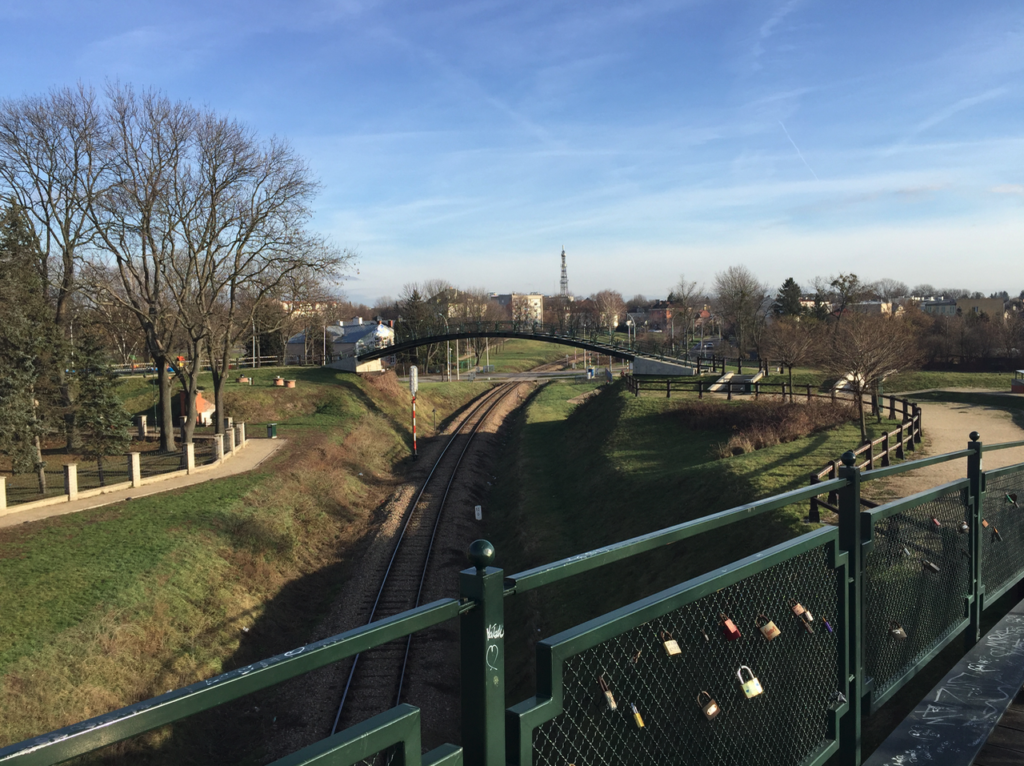
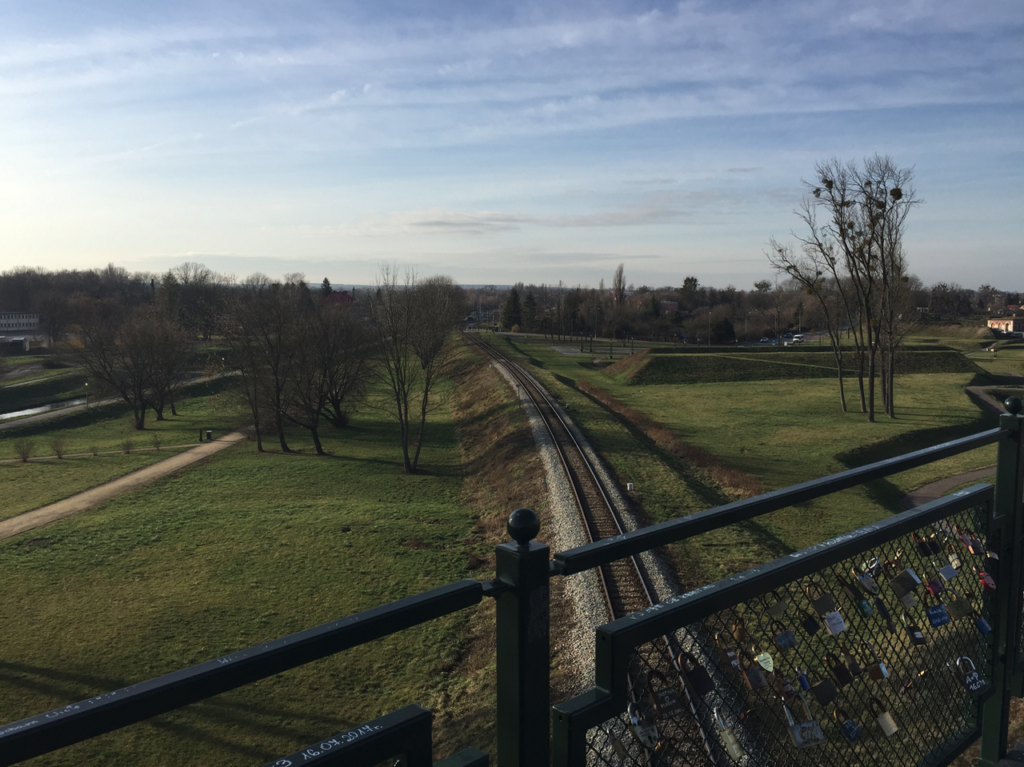
Zamojszczyzna.
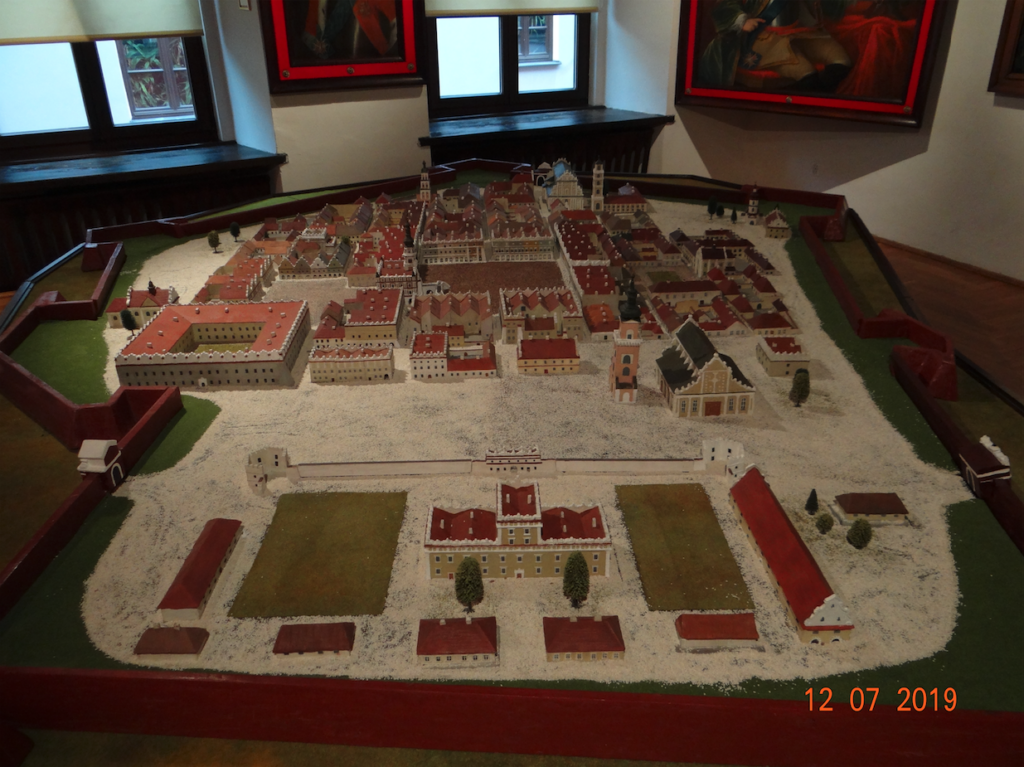
Zamojszczyzna is a historical and cultural region in southeastern Poland, in the southern part of the Lublin Voivodeship. The capital of the region is the pearl of the Renaissance, the city of Zamość. The name Zamość was established in the period 1975-1998, when the Zamość Voivodeship operated. Zamość historically belongs to Lesser Poland. For many centuries, it cooperated closely with Kraków and Sandomierz. Zamość is a purely Polish land, inhabited by a deeply patriotic and religious society, thrifty and hard-working. The Zamoyski Ordinance was the largest company in Europe at that time. Although the areas of Zamość do not fully correspond to the scope of the former Zamoyski Ordinance, established at the end of the 16th century, the above comparison is justified. After the first partition of Poland, this area found itself within the borders of the Austrian Habsburg Monarchy. In 1809, the area was ceded to the Muscovites and incorporated into the Duchy of Warsaw.
Zamość, like Jasna Góra, defended itself against the Swedish invasion. The population of the Zamość region took an active part in the November Uprising (1830) and January Uprising (1863). For many years, the society resisted the Muscovites and the Germans. During the occupation (1939-1945), the Germans displaced 100,000 residents of the Zamość region, who were sent to death camps through transit camps. Among the displaced were over 30,000 children, many thousands of whom were subjected to Germanization. The homes of the expelled Poles were occupied by Germanic colonialists from various parts of Europe. The Zamość region became a kind of testing ground for developing patterns of Germanic settlement in the East. It was an attempt to implement the policy of “Drang nach Osten”. The Germanic plan assumed the displacement of about 30 million inhabitants of Polish lands within 25 years. Their place was to be taken by 5 million Germans. That is why here, in the Zamość region, the best units of the Home Army and the National Armed Forces were formed, which fought against the Germans, Ukrainians, and later against the Muscovites.
Geographically, the Zamość Region is an area limited from the east by the Bug River and up to the city of Sokal. To the south, to Bełżec and Susiec. To the west, to the San River and up to the city of Kraśnik. To the north, to Chełm, Rejowiec and Trawniki. In the Zamość Region, there is a range of low Roztocze mountains. Roztocze is a geographical region connecting the Lublin Upland with Podolia, with a clearly raised ridge of hills, 12–32 km wide and about 180 km long, running from the northwest, from Kraśnik, to the southeast to Lviv. Roztocze is also called the Lublin-Lviv Upland. The remaining part of the Zamość Region is the Lublin Upland.
The area is mostly agricultural and forest land. Forestation is 25.3%, and agricultural land covers about 66.5% of the total area. The Zamość region has good soils that are suitable for growing wheat, rapeseed, tobacco, hops, sugar beets, and buckwheat. Many vegetables and fruits are grown here. The unpolluted natural environment creates conditions for the development of farms specializing in agritourism and beekeeping. Forest management was and is at a high level. The forests are full of wild animals.
The larger urban centers of the Zamość region are county towns: Zamość – 63,511 inhabitants (area 30.34 km2), Biłgoraj – 27,106 inhabitants (area 21.10 km2), Tomaszów Lubelski – 19,365 inhabitants (area 13.29 km2), Hrubieszów – 18,212 inhabitants (area 33.03 km2).
The history of the railway in the Zamość region.
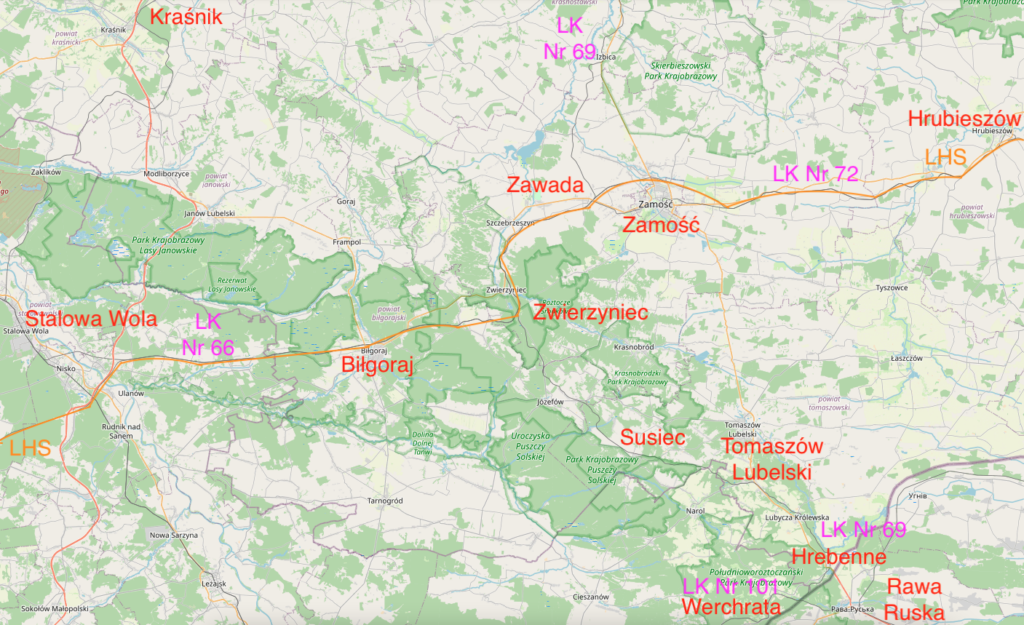
The railway arrived in the Zamość region relatively late. However, this does not mean that Zamość turned its back on the railway. Quite the opposite. Already in 1871, the 14th Zamość Ordynat Tomasz Stanisław Zamoyski, submitted to the Russian occupier a project for a Warsaw – Lublin – Zamość railway connection – to the border with the Austro-Hungarian partition. The railway was to be further extended to Lviv. The project was created in Zamość in 1868. However, the tsarist authorities rejected the project. It must be remembered that the Zamość Ordinance was one of the largest enterprises in Europe at that time.
There were even earlier plans to build a railway line that was to connect Warsaw with Central Galicia. English surveyors appeared on the Zamoyski Ordinance estates, who conducted preliminary studies for the line from Łuków through Lublin to Narol in Galicia. These engineers were Mr. Graham, Yeatman and Rethstein, together with a Polish guide, Mr. Malewski. In this case, it basically ended with just plans. Although documents were created that characterized the area of the “Lublin Governorate” as favorable for the construction of a railway, with a large potential for transporting goods (mainly by rivers) and a large population (possible passengers). The document contributed to bringing the railway to Lublin, but not to Zamość. One of the projects was called the Tomaszów Railway, because it was to run through Krasnystaw, Tomaszów Lubelski to Lviv. The cost of building the Tomaszów Railway was estimated at 15,030,000 rubles. The line would have the significance of a main line, 196 versts long. It was assumed that passenger steam locomotives would reach a speed of 60 versts per hour with a track load of up to 200 tons. Platform shelters were to be built at the Lublin, Chełm and Zamość stations.
The Zamoyski Ordinance was very involved in the construction of a railway near its territory. Funds and timber were collected for railway sleepers and telegraph poles. When the project fell through, the timber was sold for other purposes.
In 1873, the tsar in the Russian partition decided to build a railway line from Lublin to Kowel. Therefore, the 14th Zamość Ordinate, Tomasz Stanisław Zamoyski, in 1881 attempted to connect Zamość with Rejowiec. However, the plans were once again not implemented.
The Muscovites only agreed to the Lublin – Rejowiec – Chełm – Kowel line. No wonder the Turanian civilization would wear cotton wool and felt boots for centuries to come.
The Zamoyski Ordinance made another attempt. A concession was applied for to build the line: Rejowiec – Krasnystaw – Zamość – Tomaszów Lubelski. And without a state guarantee. And this time, the Muscovites refused. Count Zamoyski sent a letter to the Vistula Railway authorities, in which he informed them that if the construction of the railway towards Zamość and Tomaszów Lubelski was continued, he would give up the land owned by the Ordinance for a symbolic sum for the construction of a railway. And that did not help. In addition, the Russian occupier incited other cities to demand railway lines as well: Hrubieszów, Dołhobyczów, Sokal. As a result, at least three projects were created, which were allegedly competitive with each other. This was untrue, because at that time, the railway only affected 30 kilometers from the tracks. Carrying goods by horse transport to the railway line more than 30 km was no longer profitable. According to engineers, in the 19th century, the railway line affected 25 versts in both directions. 1 verst = 500 fathoms = 1.0668 km. According to the assessment, from the perspective of years, each project should have been implemented and would have been, only not under the authority of the Moscow state, with zero culture and low intelligence.
In January 1879, the authorities of Tomaszów Lubelski, after learning about French experiences in the field of building local railways, decided to build a railway. The route was to leave from Chełm and through Zamość and Tomaszów Lubelski and reach the Austrian border. The Moscow authorities opposed this project.
In 1887, the first standard-gauge railway in the Zamość region was launched from the Austrian partition, on the Lviv – Rawa Ruska – Bełżec section. This was an opportunity for Tomaszów Lubelski, Krasnobród and Zamość.
In 1897, Maurycy Klemens Zamoyski made another attempt. He initiated the creation of a railway company, the goal of which was the railway line: Chełm – Zamość – Tomaszów, and the station was to be built on Sadowa Street, one of the oldest streets in Zamość, north of the center. However, the railway was not established because the company had too few financial resources. In 1910, engineer councilor Dektarow (Dechtariow), supported by the Zamoyski Family Ordinance, obtained the tsarist government’s consent to build a railway line: Lublin – Turobin – Szczebrzeszyn – Tomaszów Lubelski. This was at a time when Europe was boiling and everyone knew that war would come and they were just waiting for the fuse. In May 1911, meetings were held on the final route of the line. It was planned as a main line, not a feeder line, with freight and passenger traffic. Additionally, in 1907, the authorities of Lubaczów (Austrian partition) planned to connect with the Russian line. Płazów was to be a station bordering the customs office, and the destination station was to be Lviv. As we know, the line was not built because the Great World War broke out.
The authorities of Zamość sent proposals every few years to build a railway line through the areas of the Zamoyski Family Fee. Tomaszów Lubelski was just as determined to build a railway as Zamość. The city even had a project to join the planned Kielce-Lublin line, which was very distant. The main investor was to be the Herby-Kielce railway company and a syndicate of provincial French banks.
In unknown circumstances, the tsar issued a concession to build a railway with the possibility of connecting with Austria-Hungary. The concession was constructed in such a way that a huge amount of capital was needed to build the line in a short time or the concession was lost to other entities. Count Maurycy Zamoyski had this concession, but he lost it on January 13, 1910. The concession was taken over by Waldemar von Butterdorf, but he also soon lost his concession to other people. If you don’t know what it’s all about, it’s about money. In the Muscovite state, a gang operated: engineer councilor Dektarov, director of the Putilov plant in Saint Petersburg engineer Panafilin and a silent partner, Orthodox bishop of the Eparch of Chełm Eulogiusz (secular name Vasily Semyonovich Georgievsky). The railway was to run from Lublin, through Wysokie, Turobin, Tworyczów, Szczebrzeszyn, Zwierzyniec, Kaczorki, Krasnobród, Tomaszów Lubelski to Bełżec. Unfortunately, the work was not completed.
Narrow gauge railways.
The result was that narrow gauge railways developed well in the Zamość region. They connected sugar refineries, breweries, sawmills, river ports on the Bug and warehouses.
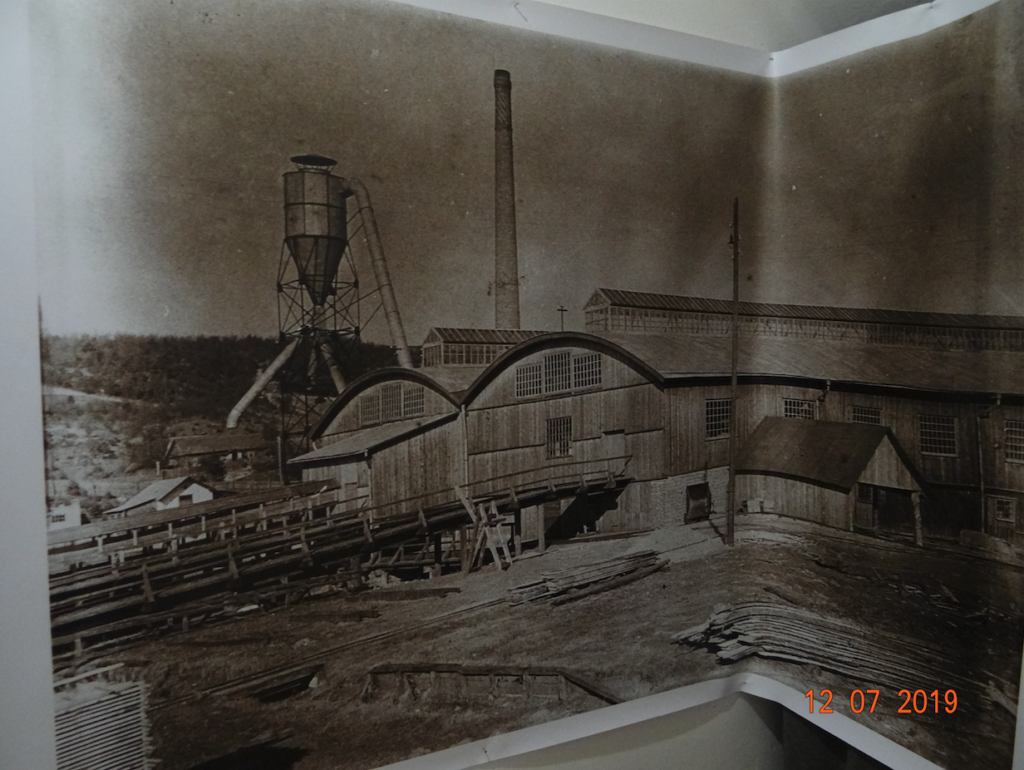
Around 1885, the Poturzyn sugar mill, also known as Dołhobyczów, built a narrow-gauge railway to the river port on the Bug in Kryłów, 19 km long. Initially, the line was with horse traction.
In 1901, a narrow-gauge commercial railway was built from the Nieledew sugar mill, near Hrubieszów, the first in the Zamość region with steam traction. In 1902, another Mircze sugar mill received a narrow-gauge commercial railway. In 1907, the first sections of the narrow-gauge railway of the Zamoyski Estate were built: Klemensów – Płoskie – Zamość and Klemensów – Bukownica.
In August 1914, the Muscovite army built a field railway (narrow gauge) from Chełm through Zamość to Biłgoraj. However, in May 1915, when the Muscovites were retreating, they dismantled the railway. In September 1915, the Austrian army built the Uhnów – Hrubieszów field railway. This railway became part of the Hrubieszów Commuter Railway. In 1951, as a result of the “regulation” of the Poland – CCCP border, the town of Uhnów and several others found themselves on the CCCP territory.
Tomaszów Lubelski gained a railway connection on 25 August 1915, when a military field railway with a track gauge of 0.600 m, built by Germanic troops, was launched. The route ran from Trawniki (a standard gauge railway station) through Zamość, Tomaszów Lubelski to Bełżec. On 20 November 1915, it was made available to the local population. However, in December of the same year (1915), as a result of changes on the front, the railway stopped operating. The section from Bełżec to Tomaszów Lubelski, 11 km long, was sold to the Directorate of the Imperial-Royal Railway in Lviv. The rest of the track, as in the case of many field railways, was dismantled and transported to another location. The remaining section of tracks was to be used to transport agricultural produce, supply the large sawmill in Tarnawatka and the brickyard in Budy Dzierążyńskie. At the end of the war it was transferred to the Ministry of Railways in Warsaw, and from 10 July 1920 to the PKP Directorate in Radom. The Bełżec – Tomaszów Lubelski line was included in the timetable in 1923, with the note “Trains not running for now”.
In 1916, the Zwierzyniec – Biłgoraj field railway was built, which became part of the Biłgoraj Commuter Railway.
It is worth mentioning that the first sugar factory railways had tracks with a gauge of 0.600 m. The Austrians used a gauge of 0.760 m, and the typical gauge was 0.750 m.
Standard gauge railways.
It was not until 1915 that a standard gauge line was built: Rejowiec – Zawada – Bełżec, i.e. when the Great World War was already underway and the railway was used for military transport. The route was built by the Germans during their offensive to the east. In February 1916, a 10-kilometer section was added from Zawada east to Zamość. In Zamość, the locomotive shed was adapted to standard gauge rolling stock.
Also in 1915, another narrow-gauge line was built, Bełżec – Tomaszów Lubelski – Zamość – Trawniki. On July 15, 1916, the railway was made available for civilian purposes. The following year, the route was extended to Nowe Miasto and in 1917, further to Hrubieszów.
In 1917, the Zamość – Werbkowice – Hrubieszów – Włodzimierz Wołyński line was built. Military trains began to reach the town of Włodzimierz Wołyński in January 1918.
In the Second Polish Republic.
In November 1918, all field and standard-gauge railways came under Polish administration. The railway in the Zamość region played an important role during the war with the Bolsheviks. It enabled the rapid transport of soldiers to the critical sections of the front. In the Reborn Republic of Poland, the narrow-gauge, economic railway was still being developed. A line from Ruskie Piaski to the town of Żółkiew, 117 km long, was built. In 1926, a network of narrow-gauge railways was built in Zwierzyniec, which served wood processing plants. The narrow-gauge Zwierzyniec – Biłgoraj route was modernized.
By 1929, the railway station building, a new locomotive shed and residential buildings for railway families were built in Zamość.
Initially, mixed passenger and freight trains ran in Zamość. Later, passenger cars were not combined with freight cars. The Włodzimierz Wołyński – Warsaw train ran through Zamość. The train was very popular and even in Zamość it was difficult to get on. Trains on the Warsaw – Lviv and Lviv – Warsaw routes passed through the nearby Zawada station. In Zamość, two or three Class 2 and 3 cars were assembled. These cars with a shunting locomotive went to Zawada. Here they were connected to trains to Lviv and Warsaw. Such a train had 14-16 passenger cars. In the 1930s, night express, long-distance trains were also launched.
During the Second Polish Republic, plans to build a Lublin-Zwierzyniec railway line were revived. The line was intended to shorten the travel time between Warsaw and Lviv, using the existing railway network. The only new track was to be the Lublin-Zwierzyniec section. However, in the face of other more important needs, the plan was not implemented, especially since there were three alternative routes.
World War II.
Railways also played an important role during World War II. The occupiers dismantled many narrow-gauge lines and built new routes for their own needs from the obtained materials. In 1941, the German occupiers began building forest railways in the Janów Forests, for predatory forest management. The Janów Forest Railway was completed in Poland in 1952.
On March 15, 1944, at the railway station in Gozdowo, 25 people, mainly railway workers, were murdered by a UPA gang. On the night of 14-15 March 1944, bloody events took place in the Hrubieszów region. At 1:30 a.m., Ukrainians attacked the railway station in Gozdowo, murdering railway workers and civilians, including women and children. The victims were travelling to Hrubieszów. The Poles were in such shock that rail traffic on the Hrubieszów railway was suspended for several months.
On July 22, 1944, the German occupiers destroyed the station equipment, switches, blew up the locomotive shed, signal boxes, bridges and burned the station. Rail traffic in Zamość was restored on September 1, 1944. On that day, the first train after the war departed. In 1945, the station in Zamość was rebuilt in a modified form. In the period 1962-1963, the station was renovated. The waiting room and the buffet received a new appearance.
It is not known which railway lines the Soviets converted to broad gauge. It is also not known which lines the Soviets dismantled and took to the east. There are no documents, because the Muscovites were not interested. Only a few memories of the residents of the Zamość region remained, who are still afraid to reveal the information they have. It is known that the Rejowiec – Zamość route was broad gauge.
After World War II.
After the Second World War, Poland found itself within new borders, imposed by the greats of this world. The Zamość region was well connected to Lublin and Warsaw. There was a significant network of PKS bus connections and a large network of narrow-gauge railways. However, there was no connection to Rzeszów, Kraków, or even Sandomierz. The Muscovites cut Poland so small that several railway lines led to fields, because there was a state border. Lviv, Rawa Ruska, and many other cities were taken from us.
The first thing that had to be done was to connect these stumps into one organism. There was line No. 130 from Munina near Jarosław, which ended in Werchrata, and previously in Rawa Ruska. This was the route of the Jarosław-Sokal Railway. Another line No. 108 from Zwierzyniec ended in Hrebenne, and previously also in Rawa Ruska. The towns of Werchrata and Hrebenne had to be connected with a relatively short line of about 10 km. The Muscovites were very careful about the Poles and as part of the “improvement of the border” they stole several more nearby Polish towns from us: Uchnów, Uchnówek and Krystynopol. In the process, they liquidated the local narrow-gauge railway. Information about the construction of the Jarosław-Sokal Railway first appeared in 1882. The first train from Jarosław to Sokal via Lubaczów and Rawa Ruska passed on July 6, 1884. On October 23, 1887, a line was built from Rawa Ruska to Bełżec (a line from Lviv), which was extended in 1916 to Rejowiec via Zawada.
The Werchrata – Hrebenne section was put into service on October 22, 1955. What’s more, the Muscovites ordered Poland to leave broad tracks in nearby stations: Werchrata, Dziewięcierz, Horyniec Zdrój. In the 1960s, this allowed the Muscovites to build a secret military transshipment base in Kaplisze, in the middle of the forests. Currently (2022), the base is unused, but the tracks exist.
In the 1950s, many workplaces built their own standard gauge railway sidings to railway stations in the Zamość region. These sidings serviced about 10,000 freight wagons per year. Hard coal, iron ore, aggregate, lumber, finished products were transported. The sidings operated until the end of the 1980s, when many factories went bankrupt due to the transformation. Over time, many sidings were dismantled. In 1959, Zamość (Hrubieszów) gained a direct connection with Kraków via Hrebenne and Lubaczów. This was a very important connection for the inhabitants of the Polish Borderlands who had been expelled by the Soviets.
In the period 1962-1963, the station in Zamość, which had been burned down by Germans in 1944, was rebuilt.
At the beginning of the 1980s, a new Zamość Bortatycze locomotive shed was built in Zamość, which serves LHS.
Railway line No. 66.
Railway line No. 66 Zwierzyniec Towarowy – Stalowa Wola Południe, aroused less emotion in Poland, but was more expensive. It is 67.48 km long. The line allowed for a significant shortening of the route from Zamość region to southern Poland.
The line was planned to be double-track and electrified. Since Poland was ruled ineptly by communists, it was not until the beginning of the 1970s that funds were obtained for the construction of a single non-electrified track. This was the time of the communist era of Edward Gierek. The 68 km section was built for five years. From 1971 to 1976. The maximum line speed is 120 km/h. The first section Zwierzyniec Towarowy – Biłgoraj was led along the embankment of the former narrow-gauge railway and was put into operation on December 21, 1971. The second section Biłgoraj – Huta Krzeszowska, was launched on August 9, 1974. And the third section Huta Krzeszowska – Stalowa Wola Południe on May 11, 1976. Due to the trend in the Polish economy at that time, consisting in “tightening cooperation with the new occupier”, the railway line No. 65 was built in parallel, i.e. LHS, Linia Slutniczo – Sulfurkowa, and currently Linia Slutnicza Szerokotorowa. Construction period 1976 – 1979. Test runs of express trains were attempted on the LHS line in the 90s, on the Olkusz – Hrubieszów section. During the Moscow invasion of Ukraine on February 24, 2022, several passenger trains with refugees from Ukraine arrived in Poland, even reaching Olkusz.
Since May 1985, the first express trains have been arriving in Zamość. Until then, there were only passenger trains. These trains use line No. 66, on which the permitted speed is 100 km/h.
In the period 1987-1991, steam traction in the Zamość region ceased. The last steam locomotive was launched in February 1991. On the night of 22/23 April 2006, the Zamość water tower burned down. It was suspected that it was arson.
The cuts made to the railways by eliminating connections in 2000 and 2004 deprived Zamość and other nearby towns of local trains. It was possible to maintain a few long-distance trains, especially those during the holidays. In 2009, only four long-distance trains arrived in Zamość. Their carriages were connected with other trains. There were two trains to Wrocław, which ran on different routes: “Hetman” and “Roztocze” and two trains to Bydgoszcz; “Bydgoszczanin” and “Chełmianin”, at different times of the day.
The worst was in 2010, when the railway launched buses instead of trains to Lublin, Chełm and Biłgoraj.
In March 2011, PKP IntrCity launched one TLK train to Zielona Góra, via Kraków and Wrocław. PKP PolRegio launched trains to Chełm and Lublin. Over the following years, the routes of these trains and the departure times changed.
In recent years, the situation has improved. Zamość has rail connections with: Warsaw, Wrocław, Rzeszów, Kraków, Częstochowa and Opole. The connections are served by the InterCity train “Hetman / Galicja”. Regional trains run to Lublin, Chełm, Rzeszów and Bełżec.
InterCity Hetman, on the route Hrubieszów Miasto – Zamość – Biłgoraj – Stalowa Wola Rozwadów – Rzeszów Główny – Tarnów – Kraków Główny – Częstochowa – Opole Główne – Wrocław Główny (ran daily).
TLK Roztocze, on the route Chełm – Zamość – Biłgoraj – Stalowa Wola Rozwadów – Rzeszów Główny – Tarnów – Kraków Główny – Katowice (ran on weekends, holidays and during the summer).
2019 – 2021.
In 2021, PKP Intercity express trains ran daily during the holidays: “Zamoyski” on the Piła – Hrubieszów route, through Warsaw, Lublin and Zamość, among others. “Hetman” on the Wrocław – Hrubieszów route, through Kraków, Rzeszów, Zwierzyniec and Zamość, among others. “Roztocze” on the Zamość – Katowice route, through Zwierzyniec, Biłgoraj, Rzeszów and Kraków. Przewozy Regionalne passenger railbuses also ran daily on the Lublin – Zamość route. Lublin – Bełżec (every day), Lublin – Bełżec – Jarosław – Rzeszów (on Saturdays and Sundays). Zamość – Bełżec – Jarosław – Rzeszów Główny (Saturdays and Sundays). Seasonal trains ran from June to September. On the Lublin–Bełżec route, two railbuses ran at 7:18 and 9:34, and the return route at 15:10 and 18:06. On Saturday and Sunday, the route was extended to Rzeszów. Meanwhile, the seasonal connection from Zamość to Rzeszów via Szczebrzeszyn, Zwierzyniec, Józefów, Susiec, Bełżec, Hrebenne, Siedliska, Werchrata, Horyniec-Zdrój, Lubaczów, Jarosław, Przeworsk and Łańcut was operated on weekends at 16:16 from Zamość and 7:43 from Rzeszów.
Example ticket prices and travel times: Lublin 16 PLN 2 h 6 min, Warsaw 42 PLN 5 h 23 min, Krakow 65 PLN 6 h 53 min, Biłgoraj 1 h 5 min, 12 PLN. Tickets can be purchased from the conductor or online. The distance from Krakow to Zamość is approximately 246 km, via Stalowa Wola Rozwadów. The train from Krakow departs at 15:01, arrives in Zamość at 21:54, after 6 h 53 min. It is possible to travel with one change in Rzeszów. A ticket purchased in advance is cheaper than a ticket purchased on the day of travel.
Zamość Railway Station.
Since 2015, the station has been owned by the City of Zamość. In the period 2018-2020, another renovation of the station building was carried out. The city’s Social Integration Center was located in the station. Part of the station is available to travelers: waiting room, buffet and toilets. Some of the rooms are occupied by railway services.
Railway traffic at Zwierzyniec station is serviced by two platforms located in both station heads. Most of the former railway buildings were demolished or changed their owners and purpose. The station had a small locomotive shed, a water tower and facilities for coaling steam locomotives.
There is one island platform with two edges at the station in Zamość, which received a new anti-slip surface a few years ago. The platform and the station building are a nice showcase of the city. The address of the railway station in Zamość is ul. Szczebrzeska 11, 22-400 Zamość. Geographic coordinates: 50.713N 23.239E. In 2018, the station served up to 200 passengers per day.
Zamość also has a passenger railway stop Zamość Starówka, at Peowiaków Street on the eastern side of the city. This stop was opened in 1969. There is another passenger stop Zamość Wschód at Jana Zamoyskiego Street, even further east of the center. A railway siding to the Technical Aviation School in Zamość branches off this line, and currently (2022) to the 3rd Mechanized Battalion.
Zwierzyniec Towarowy railway station.
Zwierzyniec Towarowy railway station used to be the main station in Zwierzyniec. Passenger trains stopped here. But it is about 2 km from the station to Zwierzyniec itself. That is why a passenger stop was built in Zwierzyniec, and the main station was renamed Zwierzyniec Towarowy. This was in 1979. There was also a narrow-gauge railway station here to Biłgoraj, which was closed in 1971.
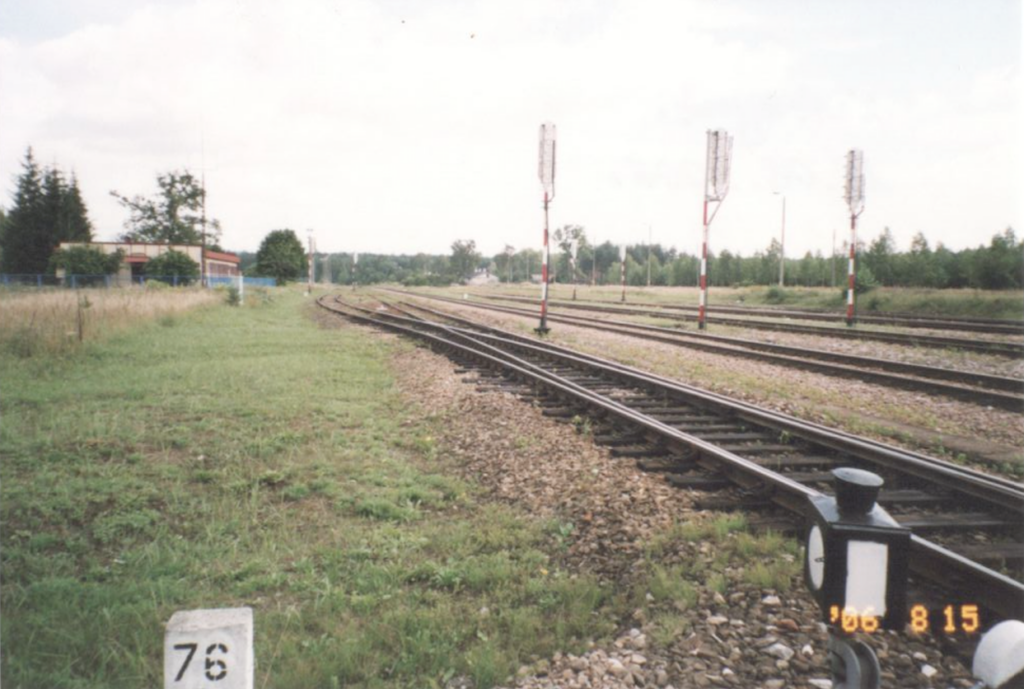
Photo description: View towards Zamość.
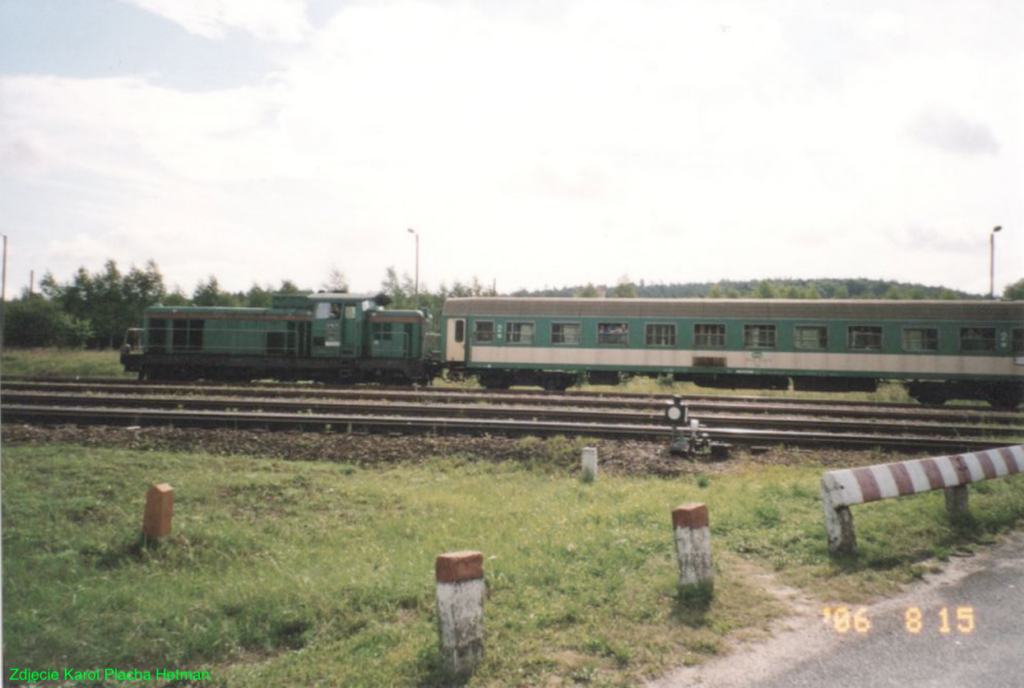
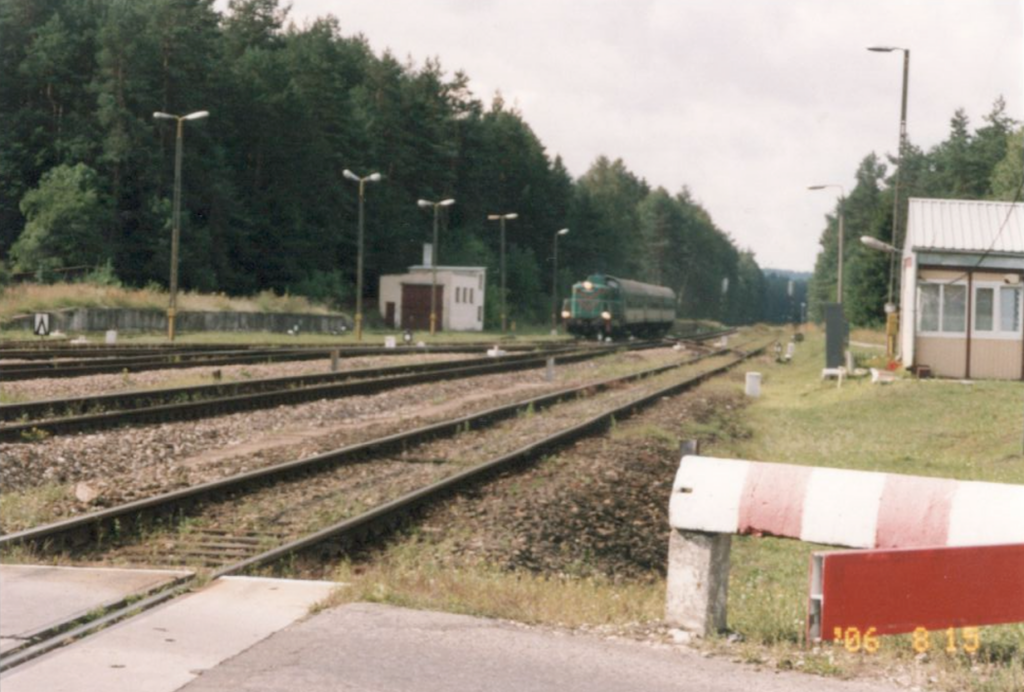
Photo description: View towards Biłgoraj and Hrebenne.
Infrastructure. 2010.
The railway infrastructure in the Zamość region is not impressive. Although, taking into account the routes of the former narrow-gauge railways, it was quite good. This was the case until the end of the 70s of the 20th century. A large liquidation of narrow-gauge railways took place in the 90s of the 20th century. Currently (2010) in the Zamość region there are 269 km of standard-gauge lines and 157 km of LHS (broad-gauge) lines.
All routes are single-track. The tracks are built on aggregate from local quarries: Nowiny, Babia Dolina and Krasnobród. Up to 60% of the tracks have wooden sleepers. The rest have concrete sleepers, but not pre-stressed concrete. Sleepers of this type were produced in the 70s and it turned out that they can crack quickly. Therefore, wooden sleepers are installed in places where the rails meet. Typical rails, about 25 m long. Due to lower financing of traffic maintenance, in several places there are restrictions on the speed of trains even to 20 km/h. Many sections have a profile similar to mountain railways, where the curves have a radius of less than 600 m. Therefore, most routes have a speed of trains up to 80 km/h, or even up to 60 km/h. There is no SHP system on the routes. However, all semaphores are light. In 2004, the last shape semaphores were eliminated at the Szczebrzeszyn station. In 2019, there were still two last shape semaphores at the station in Krasnystaw. At the Szczebrzeszyn and Zawada stations, modernization allowed only one signal box to be left. At other stations, the vast majority of switches and turnouts are operated manually by railway employees.
In general, there are few technical railway devices in the Zamość region, such as bridges, viaducts and culverts. Only at the Susiec station is there a passage under the railway tracks. Almost all intersections with roads are on one level, i.e. typical crossings with barriers or without barriers. This situation generates a lot of damage to diesel locomotives caused by careless car drivers. Crossings with barriers are operated by railway employees. There are practically no automatic crossings.
It is worth mentioning the attempt to electrify the routes in the Zamość region. To date, no railway line has been electrified. This does not mean that there were no such plans. The furthest work was carried out on the Krasnystaw – Rejowiec section. Around 1989, concrete traction poles were already erected here. A medium voltage line consisting of three wires was placed on the tops of the poles. The traction wires were not hung anymore.
The rolling stock running in the Zamość region, on local lines, are primarily vehicles belonging to the Lublin Province. The operator is the Lublin Province Self-Government. The rolling stock includes about 15 pcs and railbuses. The train includes SA107, SA103, SA134 type vehicles. The following diesel locomotives are used: SM42, SM4210, ST44 and SU160.
On January 8, 2022, the heaviest and longest freight train in Poland passed through the LHS line. The freight train was 924 m long, had a gross weight of 5,883 tons and carried iron ore from Ukraine in 66 wagons. So far, the heaviest train in Poland passed through in April 2020, from Tarnowskie Góry to Łódź. In Freightliner colours it carried 4,020 tonnes of aggregate, and the gross train weight was 5,167 tonnes. A typical freight train in Poland weighs about 2,000 tonnes.
Written by Karol Placha Hetman
